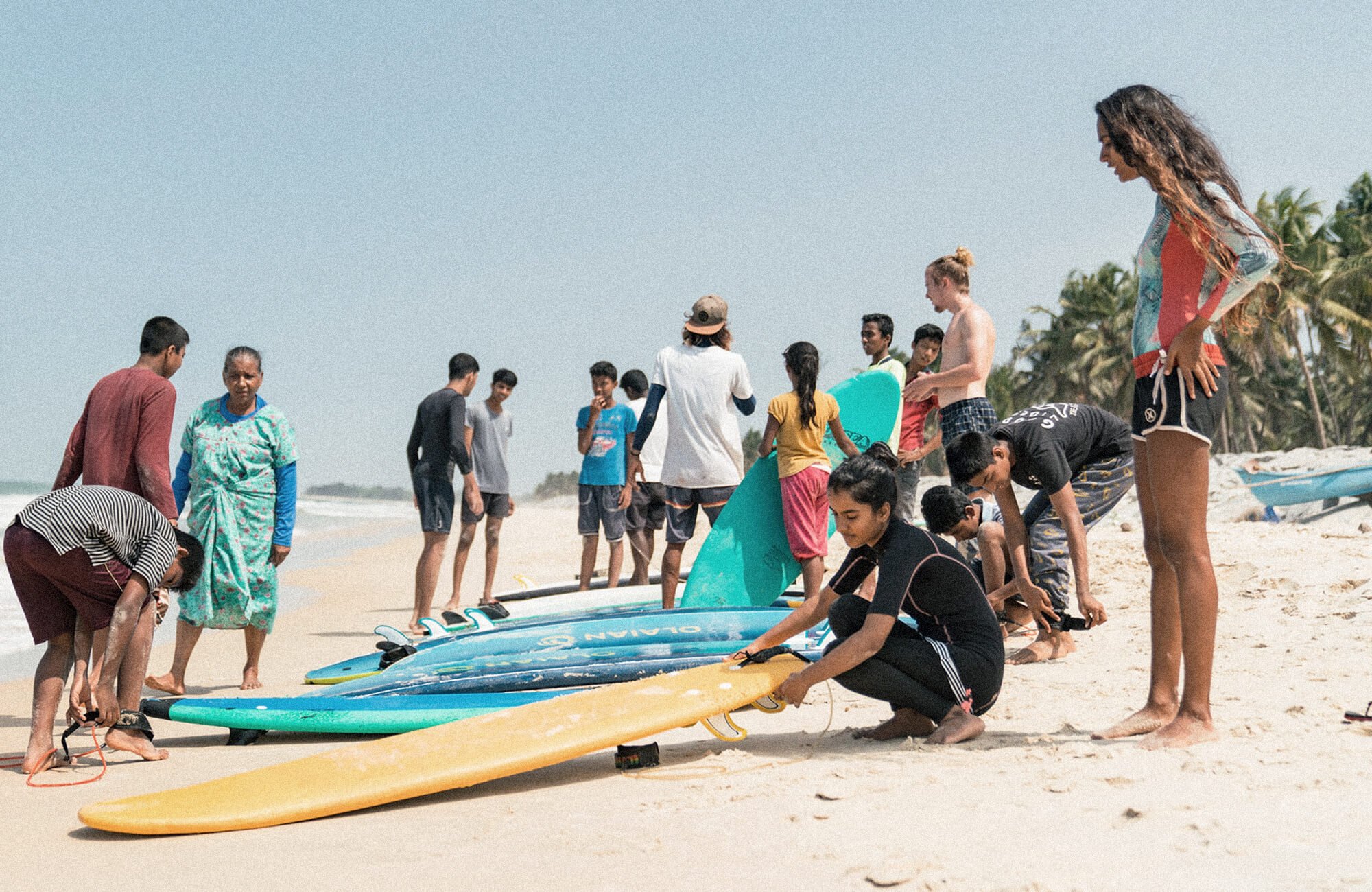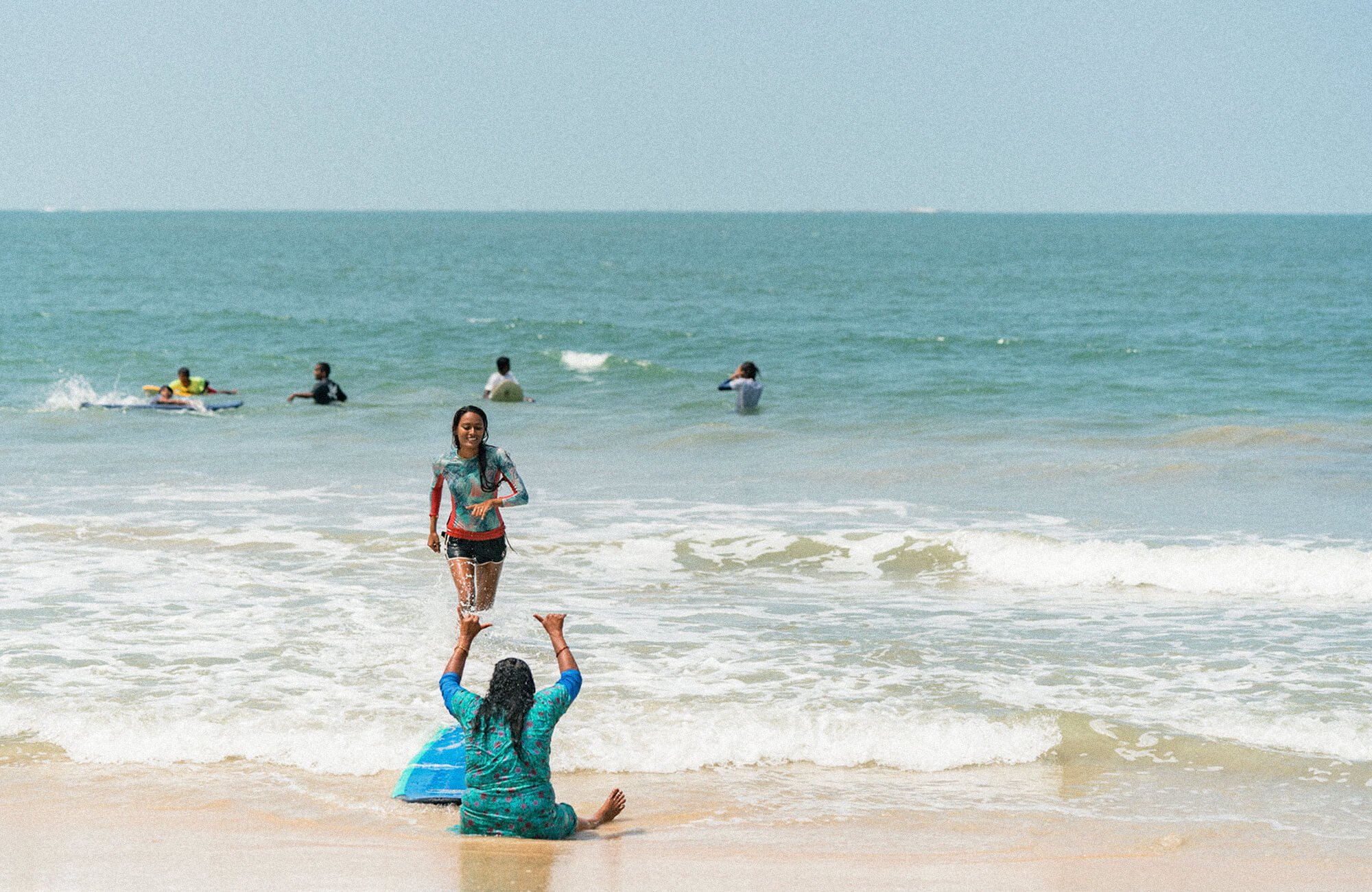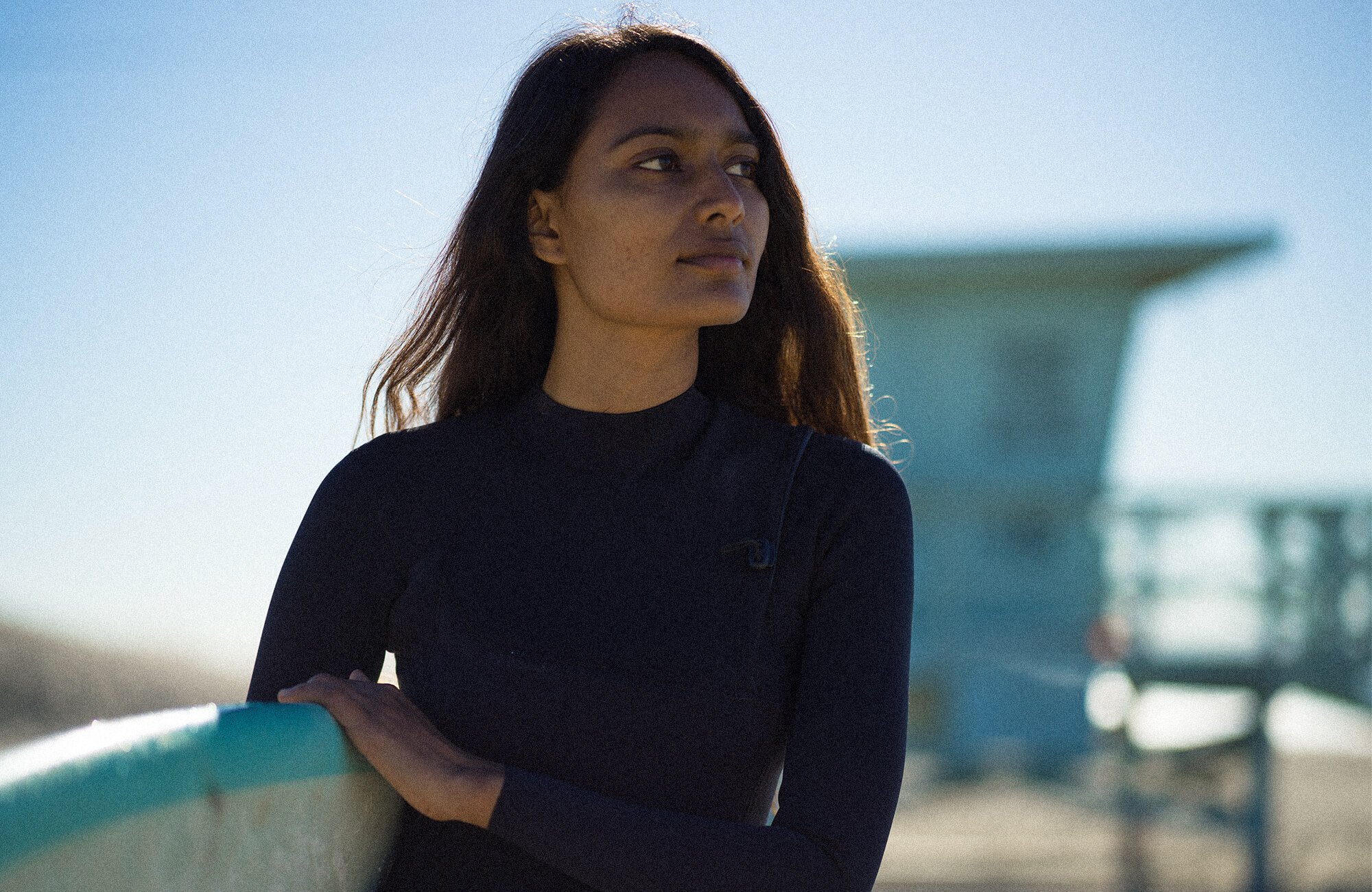PIONEERING SURFING FOR WOMEN IN INDIA
WE CATCH UP WITH INDIA’S FIRST PROFESSIONAL FEMALE SURFER, ISHITA MALAVIYA, TO DISCUSS THE OCEANS AND BREAKING DOWN BARRIERS IN THE SURFING COMMUNITY
Image courtesy of Ishita Malaviya
Despite an abundance of coastline, long stretches of beach and swell on both sides of the country, India has traditionally been a surf-shy nation. Over the past decade, the tide has gradually started to turn as more individuals take up the activity of surfing, including Ishita Malaviya, India's first professional female surfer and one of the early pioneers of the sport in her country.
Her love for surfing first started when she was introduced to a German exchange student in 2007 when there were only 13 professional surfers in India – a literal drop in the ocean amid what was then a population of 1.2 billion.
Since catching her first wave, Malaviya has been hooked. Today, her mission is to integrate communities through surfing, to increase gender equality in sports participation, and to increase awareness around sea safety following several drowning incidents. She has gone on to co-found the Shaka Surf Club with her friend Tushar Pathiyan which provides lessons, board rentals and accommodation for people of all ages.
Images by Jo Savage Photography
“representation matters because growing up I never really saw images of water women that looked like me.”
YOU ARE INDIA’S FIRST FEMALE PROFESSIONAL SURFER, TELL US WHY IS THIS SIGNIFICANT TO YOU AND YOUR COUNTRY?
I think representation matters because growing up I never really saw images of water women that looked like me. Traditionally, the ocean has always been looked at as a treacherous place reserved for men who go fish at sea. Having no other women surfers to watch and learn from when I was starting out, I know how intimidating it can feel to be the only woman in the lineup. So I think it’s important for young girls and other women in my country to see me; someone they can relate to, and feel inspired to think “If she can do it, I can do it.” Also, in a country where advertisements perpetuate the notion that fair skin is the epitome of beauty and marker for success, I feel like it’s my personal responsibility to challenge that bias and be a positive role model for brown skin women so they too may feel comfortable and confident in their skin and the knowing that dark skin is beautiful too and by no means a deterrent to success!
HOW DID YOU FIRST GET INTO SURFING AND HOW WAS IT RECEIVED IN YOUR COMMUNITY? HOW DO YOU PLAN TO GET OTHER INDIANS, SPECIFICALLY WOMEN, INVOLVED IN SURFING?
Growing up, I always dreamed of learning to surf, but I had never heard of anyone doing it in India and just assumed that there were no waves here and that I would probably have to travel abroad to start surfing. However, it was during my first year of University, that my friend Tushar (Co-Founder of The Shaka Surf Club) and I were introduced to a group of Californian surfers who were living in an ashram nearby. They were stoked to see two Indian kids interested in surfing and gladly pushed us into our first waves. Instantly, it was like a switch went off in our heads and we both knew we wanted to be surfing for the rest of our lives. We just had to figure out how because we were stoked but also equally broke. So we hustled and sold everything we possibly could and saved up enough money to buy a second hand board which we shared. Through a series of epic wipeouts, nosedives and bruises over the next two years we managed to teach ourselves how to surf.
Mind you, this was back in 2007 and if you literally Googled “Surfing in India” nothing would show up. So obviously our parents didn’t get it at first. They couldn’t understand why we were spending so much time at the beach and wanted us to just focus on our studies. Understandably so. But after a few years of getting used to waking up early everyday and catching waves before heading for class, we could no longer imagine moving back to the city, doing a 9 to 5 job and being unable to surf. Especially having come from a big city like Mumbai where the waters are so polluted, we were so grateful to discover this little fishing village where the stretch of coastline was still pristine. It became a personal mission of ours to protect it for as long as we could.
One of the things we noticed was that most people in India live in fear of the ocean and even many fishermen themselves don’t know how to swim. Our main goal for starting The Shaka Surf Club was to help dispel fears by getting more people in the water and introducing them to the joy and healing powers of surfing. We realised that it’s only when people experience a deeper connection with the ocean, that they’ll develop a greater sense of appreciation and respect for it and want to protect it. The Shaka Surf Club is primarily a surf camp and we welcome people from all over India and the world to come and learn to surf with us. We work very closely with the local community by keeping surfing and skateboarding free for all the kids in the village and collaborate with their moms and grand-moms who prepare home cooked meals for guests at our surf camp. We even have a 65 year old grandma who comes to surf with us sometimes! When we first came to the village we didn’t speak the local language.
We saw these kids growing up by the beach but never stepping in the sea, having no clue what an abundant playground they had in their backyard. Surfing is an expensive sport and knowing how difficult it was for us to have access to it when we were starting out, we didn’t want these kids to miss out. So we started taking them surfing and communicated with their families using smiles and shakas and it was through that interaction that we were able to build trust and be welcomed into the community.
We also knew that the kids are the future guardians of the place and change starts with them. So we volunteer our time conducting several workshops in the village school as well, raising environmental awareness and levels of stoke while bridging barriers of culture, gender and faith! I must admit that it’s been a challenge especially motivating girls to get in the water due to the cultural pressures they face at home. It’s something I’ve realised I can’t do single-handedly. They need to be surrounded by other strong Indian women role models so they can feel more confident and inspired to start surfing. In the future I definitely plan to run surf camps just for women and would also like to gather a group of women volunteers to help conduct swim, surf and outdoor activities with the young girls in the village.
Image by Jo Savage Photography
Image by Jo Savage Photography
WHAT DO YOU LOVE MOST ABOUT THE OCEANS AND/OR SURFING?
The ocean is my sacred playground. I go to the sea for silence, solitude and reflection. I like to think of the ocean as the Womb of Mother Earth, in which all life on this planet was born. So being in the sea always gives me the feeling of coming home. It makes me feel held and supported and in the expanse of the sea I can wash all my worries away. I always step out of the saltwater feeling lighter, and energized. The thing I love most about surfing is that it makes me feel like a kid again. I feel like as a woman in India, you’re sometimes forced to grow up too soon. Surfing brought back an element of play in my life and gave me a sense of freedom and liberation that I didn’t know I was seeking, but desperately needed. I encourage people to develop a deep connection with the ocean for its immense potential to bring joy and healing. Water is the sacred element that connects us all. The more gratitude we feel towards water, the greater assistance we will receive from it in our lives. I wish for the waters of the world to be healed just as the water heals us.
WHAT IS YOUR EARLIEST MEMORY OF THE OCEANS?
I grew up in the coastal city of Bombay and my primary school was right by Juhu beach. Some of my fondest earliest memories by the sea are from that time when our teachers would take us down to play on the beach every day. We would go swimming and build sandcastles, the water wasn’t polluted back then as it is now. I guess that’s where my love for the sea began. I’ve always been a water baby and of course The Little Mermaid was my favorite Disney princess.
Image by Jo Savage Photography
Image by Jo Savage Photography
“We need to step out of that out of sight, out of mind mentality when it comes to the trash we are creating and educate ourselves about where it ends up. ”
WHAT IS YOUR DREAM FOR THE FUTURE OF YOUR COMMUNITY, COUNTRY? WHAT IS YOUR DREAM FOR THE FUTURE OF OUR OCEANS?
I think as surfers especially, we see first hand the changes in water temperature and its effects on our environment. I’d like to see more people from all walks of life surfing in India, feeling inspired to work collectively towards cleaning up our seas.
I look at a city like Mumbai with a population of over 20 million people and think that as much as organizing local beach cleanups is important, we really need to demand action from our governments to implement policies that prevent raw sewage from being drained into the sea and stricter packaging laws that require big businesses to make their products and practices eco-friendly to ensure that plastics don’t end up in our oceans. We need to step out of that out of sight, out of mind mentality when it comes to the trash we are creating and educate ourselves about where it ends up.
If that’s the case in the big cities, it’s not surprising that the village we’re based in doesn’t even have a garbage disposal system. Most people either burn their trash or chuck it into the river. When putting food on their plates is their main priority, worrying about their impact on the environment is low on their list of concerns. Yet, with fishing being their primary source of income, these are the communities that are the most affected by declining numbers of fish each year or rising sea levels threatening to wash away their homes. I love listening to the old fishermen tell me stories about the days before the huge fishing trawlers when their fishing practices were sustainable and the seas were teeming with so much fish they didn’t need to store them, and would literally walk up to the beach and scoop them up in buckets. I listen in awe as that’s a reality I never witnessed but really want to be able to!
Our ancestors knew the ways of maintaining the delicate balance, to take only what we need and allowing the ecosystem to regenerate. The knowledge is still there, and I hope that we recalibrate our actions, because at the rate at which we’re going, our kids will only get to read about fish in history books! I wish to be able to empower these vulnerable coastal communities with affordable solutions and opportunities to make a living, in harmony with nature, so they may be able to protect these sacred spaces for future generations to come and preserve their culture rather have it be lost by selling their land to those that only seek to exploit it for profit.
With frequent power cuts and water supply only every alternate day, these people are already living within their means. One of our goals at The Shaka Surf Club is also to be able to have the whole village running on solar power in the future.
HOW DO YOU STAY MOTIVATED?
Honestly, there are times when I feel super overwhelmed and vulnerable and feel like in spite of how far we’ve come, it’s a constant uphill battle in terms of the cultural resistance we face, and external forces threatening to disrupt the delicate ecosystem we’ve created.
Sometimes I feel like no one cares and I wonder why do we even bother trying to do the work we do? But then I see the kids surfing and skateboarding and smiling and throwing shakas at us as we drive down the village road, the mothers and grandmothers that are grateful for the additional means of income our business provides and the quality time it allows them with their families, and the one burkha clad surfer girl who defies cultural expectations of her and comes surfing!
When I see kids showing up for beach cleanups and calling people out for littering the beach, it gives me hope. It reminds me that there is a community that depends on us and shares our vision for the future and even though change is slow it’s worth it to keep persevering.
WHAT IS YOUR FAVORITE OCEAN ANIMAL AND WHY?
It’s tough to pick just one. But I especially love dolphins and sea turtles because they show up when we’re surfing and they’re such playful, gentle and wise creatures. It’s really sad to see how many of them wash up dead on our shores, entangled in fishing nets or choking on plastic. So many sea turtles get accidentally caught in the huge trawling nets and drown because they can’t come up to the surface to breathe. By the time the fishermen spot them it’s already too late. I wish there was a better mechanism in place to prevent that from happening. With so much debris like discarded fishing equipment or plastics bottles from different parts of the world washing up on our coastlines everyday, we need to be more conscious of the products we are consuming and where they end up.
DO YOU HAVE ANY OCEAN HEROES? IF SO, WHO ARE THEY?
Yes, some of my favorite ocean SHEROES are Captain Liz Clark, Kimi Werner and Belinda Baggs. I’m so inspired by their kind, positive, compassionate natures and the way they use their voices to advocate for the environment and walk the talk by living simply and within their means, and suggest ideas for daily activism that we can all incorporate into our lives to contribute to a better world. Organizations like Changing Tides Foundation and Surfers for Climate are doing great work in empowering women, mobilizing movement for positive climate action and giving back to local communities.
Q&A originally published on Parley











